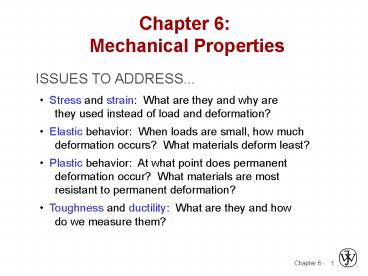Chapter 6: Mechanical Properties - PowerPoint PPT Presentation
1 / 24
Title:
Chapter 6: Mechanical Properties
Description:
they used instead of load and deformation? Elastic behavior: When loads are ... Toughness and ductility: What are they and how. do we measure them? Chapter 6: ... – PowerPoint PPT presentation
Number of Views:207
Avg rating:3.0/5.0
Title: Chapter 6: Mechanical Properties
1
Chapter 6 Mechanical Properties
ISSUES TO ADDRESS...
Stress and strain What are they and why are
they used instead of load and deformation?
Elastic behavior When loads are small, how
much deformation occurs? What materials
deform least?
Plastic behavior At what point does
permanent deformation occur? What
materials are most resistant to permanent
deformation?
Toughness and ductility What are they and
how do we measure them?
2
Elastic Deformation
Elastic means reversible!
3
Plastic Deformation (Metals)
Plastic means permanent!
4
Engineering Stress
? Stress has units N/m2 or lbf/in2
5
OTHER COMMON STRESS STATES (1)
Simple compression
Note compressive structure member (s lt 0 here).
(photo courtesy P.M. Anderson)
6
OTHER COMMON STRESS STATES (2)
Bi-axial tension
Hydrostatic compression
Pressurized tank
(photo courtesy P.M. Anderson)
(photo courtesy P.M. Anderson)
7
Linear Elastic Properties
Modulus of Elasticity, E (also known as
Young's modulus)
8
Poisson's ratio, n
Poisson's ratio, n
metals n 0.33ceramics n 0.25polymers n
0.40
Units E GPa or psi n dimensionless
- ? gt 0.50 density increases
- ? lt 0.50 density decreases
(voids form)
9
Mechanical Properties
- Slope of stress strain plot (which is
proportional to the elastic modulus) depends on
bond strength of metal
Adapted from Fig. 6.7, Callister 7e.
10
Youngs Moduli Comparison
Graphite Ceramics Semicond
Metals Alloys
Composites /fibers
Polymers
E(GPa)
Based on data in Table B2, Callister
7e. Composite data based on reinforced epoxy with
60 vol of aligned carbon (CFRE), aramid (AFRE),
or glass (GFRE) fibers.
109 Pa
11
Plastic (Permanent) Deformation
(at lower temperatures, i.e. T lt Tmelt/3)
Simple tension test
ElasticPlastic
at larger stress
engineering stress, s
Elastic
initially
permanent (plastic)
after load is removed
ep
engineering strain, e
plastic strain
Adapted from Fig. 6.10 (a), Callister 7e.
12
Yield Strength, sy
Stress at which noticeable plastic deformation
has occurred.
when ep 0.002
?y yield strength Note for 2 inch sample ?
0.002 ?z/z ? ?z 0.004 in
Adapted from Fig. 6.10 (a), Callister 7e.
13
Yield Strength Comparison
Room T values
Based on data in Table B4, Callister 7e. a
annealed hr hot rolled ag aged cd cold
drawn cw cold worked qt quenched tempered
14
Tensile Strength, TS
Maximum stress on engineering stress-strain
curve.
Adapted from Fig. 6.11, Callister 7e.
Metals occurs when noticeable necking
starts. Polymers occurs when polymer
backbone chains are aligned and about to
break.
15
Tensile Strength Comparison
Room Temp. values
Based on data in Table B4, Callister 7e. a
annealed hr hot rolled ag aged cd cold
drawn cw cold worked qt quenched
tempered AFRE, GFRE, CFRE aramid, glass,
carbon fiber-reinforced epoxy composites, with 60
vol fibers.
16
Ductility
Plastic tensile strain at failure
Adapted from Fig. 6.13, Callister 7e.
17
Toughness
Energy to break a unit volume of material
Approximate by the area under the stress-strain
curve.
Brittle fracture elastic energyDuctile
fracture elastic plastic energy
18
Resilience, Ur
- Ability of a material to store energy
- Energy stored best in elastic region
If we assume a linear stress-strain curve this
simplifies to
Adapted from Fig. 6.15, Callister 7e.
19
Elastic Strain Recovery
Adapted from Fig. 6.17, Callister 7e.
20
Hardness
Resistance to permanently indenting the
surface. Large hardness means
--resistance to plastic deformation or cracking
in compression. --better wear
properties.
21
Hardness Measurement
Table 6.5
22
True Stress Strain
- Note S.A. changes when sample stretched
- True stress
- True Strain
Adapted from Fig. 6.16, Callister 7e.
23
Hardening
An increase in sy due to plastic deformation.
Curve fit to the stress-strain response
24
Summary
Stress and strain These are
size-independent measures of load and
displacement, respectively.
Elastic behavior This reversible behavior
often shows a linear relation between
stress and strain. To minimize deformation,
select a material with a large elastic
modulus (E or G).
Plastic behavior This permanent deformation
behavior occurs when the tensile (or
compressive) uniaxial stress reaches sy.
Toughness The energy needed to break a unit
volume of material.
Ductility The plastic strain at failure.































